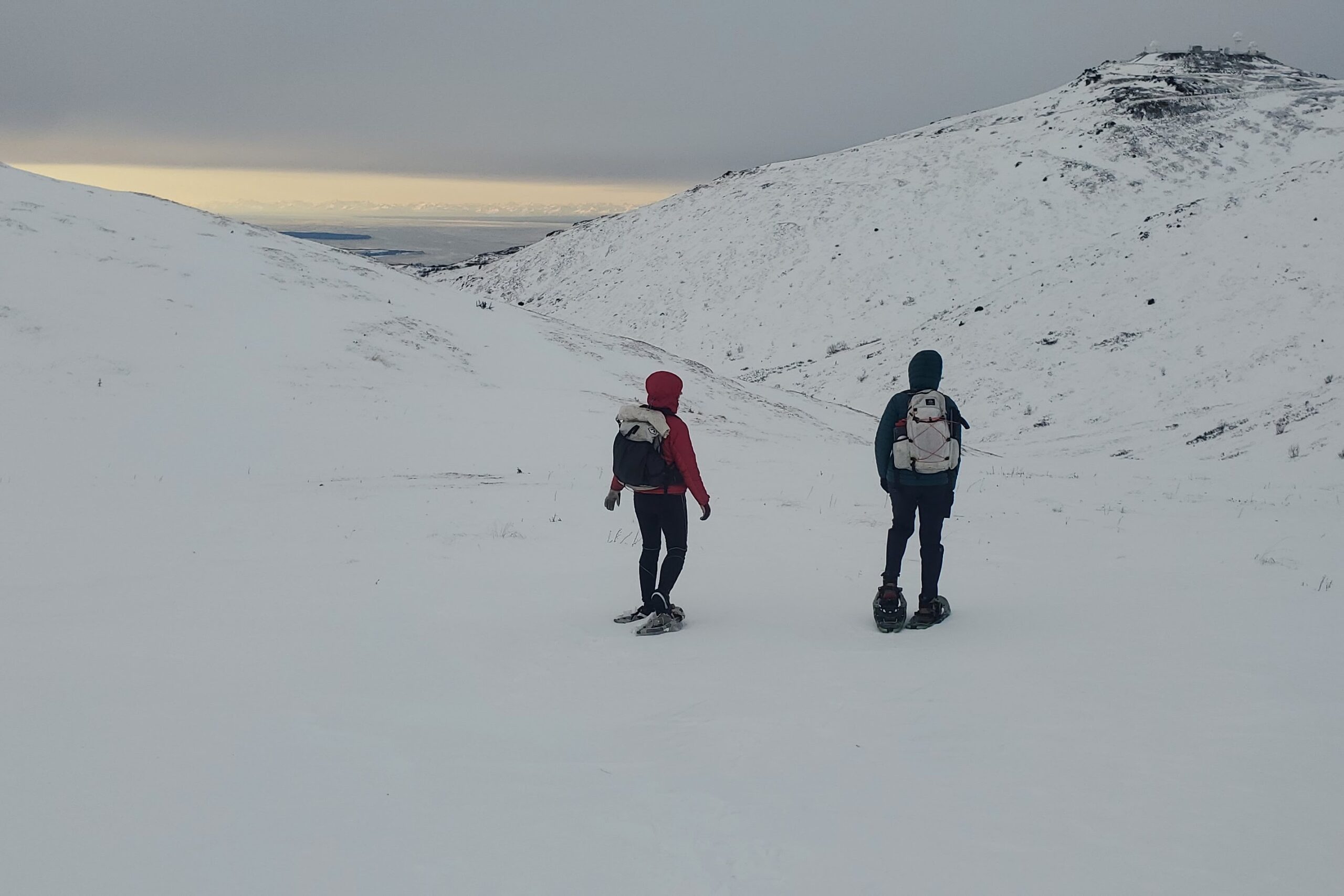
Bottom Line
True to its namesake, the Tubbs Mountaineer is a worthy snowshoe for rugged adventures in deep snow and is a great option among our lineup of the best snowshoes we tested. Featuring the reliable and time-tested construction of a tubular aluminum frame and flexible decking, the Mountaineer speaks to those who like a traditional design with modern components.
The binding system features two straps for the midfoot attached to Tubbs’ ActiveFit 2.0 binding system. A thin rubberized strap connects the two levers that release both straps with one easy pull. The binding is easy to slip on and off, but we found fits large-volume boots best. The binding does not tighten in the toe of the boot, leaving all the pressure across the bridge of the foot. This can cause discomfort when tightened.
With an easily deployable heel riser, carbon steel crampons, and a wide frame, the Mountaineer is an off-trail beast fit for mountain adventures. Its heft feels clunky and cumbersome on packed trails but allows it to pound through breakable crust and off-trails conditions easily.
Quick Specs

Flotation
While climbing up alpine slopes, punching breakable crust, and plowing through deep powder, we found that the Tubbs Mountaineer is one of the best-suited snowshoes we tested for off-trail travel. Its wide profile provides excellent flotation, and the traditional aluminum frame and flexible decking excel in deep snow.
The tips of the snowshoes taper to a rounded point that helps to cut through deep powder with each step without compromising flotation. A relatively narrow toe opening sheds snow with each step but still has enough decking to be supportable. We will keep reaching for these snowshoes when heading into deep snow.

Traction
While aluminum tube framed snowshoes have less traction than their more modern counterparts, we found the traction of the Tubbs Mountaineer to be among the best for this construction style. With Tubbs’ Anaconda toe crampons, we never wished for more grip. With eight teeth in the midfoot arranged in an oval, kicking steps while marching uphill was secure and we never went for a backward slide..
The heel has six rearward-facing teeth that provide great purchase going up and downhill. Two more teeth facing perpendicular to the rest aid in maintaining purchase when going downhill. When descending a steep slope, we did not feel any sliding on the tails common to simpler snowshoes. We highly recommend these for climbing or descending steep hills.

Walkability
The Tubbs Mountaineer surprised us with their walkability. Their rockered profile with a slight rise in the tips and tails made all the difference. This design is somewhat unique to tubular frame snowshoes, and we especially loved the slightly raised tails for descents. While the tapered tail eliminates most overlap, we found that these snowshoes are uncomfortable when walking across slopes. Their noticeable width puts pressure on the ankle while side-hilling. We enjoyed this model the most while going straight up or straight down.
These are some of the heaviest snowshoes in our lineup, and their weight was evident after a few hours of walking. They are bulky and heavy and feel clunky on packed trails. Most at home in the deep snow, this snowshoe is not the best for a light and fast option.

Ease of Use
The bindings of the Tubbs Mountaineer feature a semi-rigid frame that makes it easy to slide the foot in and out. A strap on either side is easily tightened by pulling the tails through the ratchets. A unique feature of these snowshoes is that a connecting strip of rubberized material attaches both release levers. This makes stepping out of the snowshoes simple with a single pull to release both straps.
Despite their ease of use, we found the bindings of the Mountaineer to have some shortcomings. The frame that makes up the binding only tightens across the bridge of the foot. Adequately tightening these down requires applying uncomfortable pressure to the bridge of the foot while the toes remain open and not tightened. We tested these bindings with both low and high-volume boots and encountered the same problem. The toes of the boot remain unsecured, while the bridge is painfully tight. If you know that you have large-volume feet and boots, these will probably work better for you than those with smaller feet.

Should You Buy the Tubbs Mountaineer?
If you’re someone who spends the majority of their time off the beaten path and walking through deep snow, then the Tubbs Mountaineer is the perfect snowshoe for you. Its large surface area and many length options offer great flotation in deep powder. A strong array of claws in the midfoot and heel provide excellent traction.
The binding system, while simple to use, lacks the comfort and security of others we have tested. Best suited for large-volume feet, the binding has a hard time accommodating smaller-volume boots without uncomfortably pressing on the bridge of the foot. With its higher price tag, heftier weight, and beefier construction, the Tubbs Mountaineer is best suited for an experienced snowshoer who plans to spend time in deep snow and steep terrain.

What Other Snowshoes Should You Consider?
Atlas Montane Review – With a nearly identical construction, the Atlas Montane closely resembles the Mountaineer but with a simpler strap binding that fits narrower boots better.
MSR Lightning Ascent Review – If you loved the traction of the Mountaineer but are looking for even more, the MSR Lightning Ascent features some of the largest crampons we’ve seen combined with full-frame traction for best-in-class grip.
Tubbs Wayfinder Review – With a similar tubular aluminum construction, the Tubbs Wayfinder is the little cousin to the Mountaineer. With more walkability and an easy-to-use boa binding, it’s most at home on trails and rolling terrain.


















